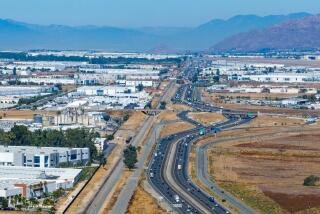Eased Controls Pave Way for Coastal Resort
- Share via
For almost a century, the salt-sprayed headlands of the bucolic Central Coast north of Cambria have escaped the tide of development that has washed over much of the state’s Pacific shores.
The era of rural tranquillity may have come to an official end this week, however, with a sweeping decision by the San Luis Obispo County Board of Supervisors to relax growth controls, paving the way for commercial and residential construction on 2,000 acres of coastal hills and meadows.
The centerpiece of the planned new development--which must still be approved by the California Coastal Commission--is the Hearst Corp.’s proposed multistage resort consisting of three hotels, a dude ranch and a 27-hole golf course. The buildings would be spread across the wide-open country between the ocean and the late William Randolph Hearst’s famous castle.
Two hotels and a cluster of shops would be built along the base of San Simeon Point amid a forest of Monterey pine, cypress and eucalyptus. The planned golf course would be perched over an empty stretch of coast where the only inhabitants now are a few cows and a sprawling colony of elephant seals.
Lawyers for the corporation note that the buildings would occupy less than 1% of the 118,000-acre Hearst ranch. But critics say that by clustering much of the development, including the golf course, on the Pacific side of California 1, the company would be turning one of California’s most majestic shorelines into a busy commercial corridor.
“It’s the beginning of Orange County north,” said Mike Massara, a lawyer in charge of coastal protection for the Sierra Club.
“The north Central Coast is for sale. That’s the message sent by the board,” said Shirley Bianchi, a county planning commissioner who lives near the Hearst ranch.
But Supervisor Mike Ryan, whose election last fall provided the key pro-development swing vote, argued that new hotels, shops and restaurants would allow more people to enjoy the beauty of the region.
“Up to now, it’s been kind of a drive-by experience,” Ryan said. “People come up, visit the castle and leave, all in one day. Now, more people can take the time to hike or bike. Plus, they will spend more money and that will help the economy.”
But local planning officials warn that the Hearst development, along with two large subdivisions also approved by the board, could expand the local population, which is only 6,000, by 20% or more, and overwhelm two-lane roads, rural schools and water systems.
“We’re talking about at least one new community in an area where there isn’t a drop of water,” said county planner John Hofschroer.
Nor is Cambria or nearby San Simeon equipped with adequate firefighting resources, Hofschroer said. “There isn’t a hook-and-ladder rig in miles.”
The county’s new North Coast plan also removes language that assured “minimum” public access to the coast.
It is not easy to reach the shoreline here without crossing Hearst lands, which extend for 20 miles north of Cambria almost to the Monterey County border and the southern reach of Big Sur. For 60 years, people have enjoyed the freedom of access to explore the bluffs, beaches and coves.
The plan now says that access will be worked out with each new phase of coastal development.
“Up to now, there has been a firm delineation of minimum coastal access,” said Kat McConnell, who heads the county’s north coast citizens advisory committee. “Hearst lawyers objected to the language. So the supervisors removed the guarantees and that leaves the future up in the air.”
Supervisor Ryan maintained that the new plan strengthens access by retaining more public open space on San Simeon Point and requiring the Hearst Corp. to abandon its original plan to build out onto the point.
But Ryan acknowledged that Hearst and other developers now will be able to develop substantially more of their property than previously contemplated.
“The prior board cut them down small enough to where it wasn’t economical to build,” Ryan said. “It amounted to their trying to stop the project entirely.”
The Hearst Corp. was allowed to boost the size of its project by nearly 100%, to 650 rooms in the three hotels and the dude ranch.
In Cambria’s coastal zone, developers of a 1,200-acre former ranch were given permission to reduce minimum lot sizes from 160 acres to 20 acres, according to the county planning office. And developers of Cambria’s East West Ranch, a planned 400-acre subdivision overlooking the ocean, won the tentative right to build 265 homes on property limited by the previous Board of Supervisors to 130 home sites.
More to Read
Sign up for Essential California
The most important California stories and recommendations in your inbox every morning.
You may occasionally receive promotional content from the Los Angeles Times.













